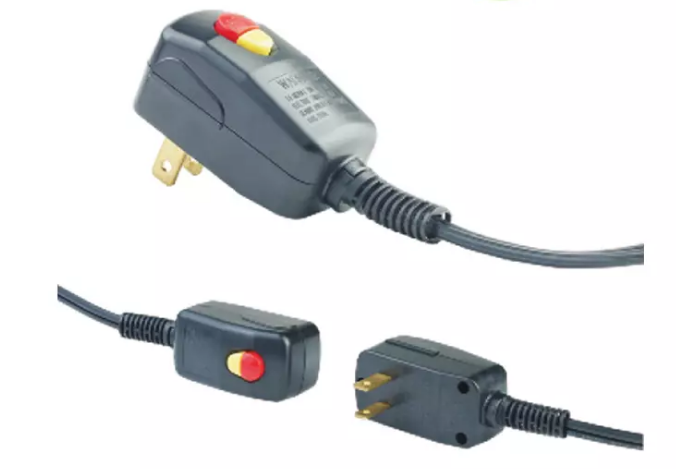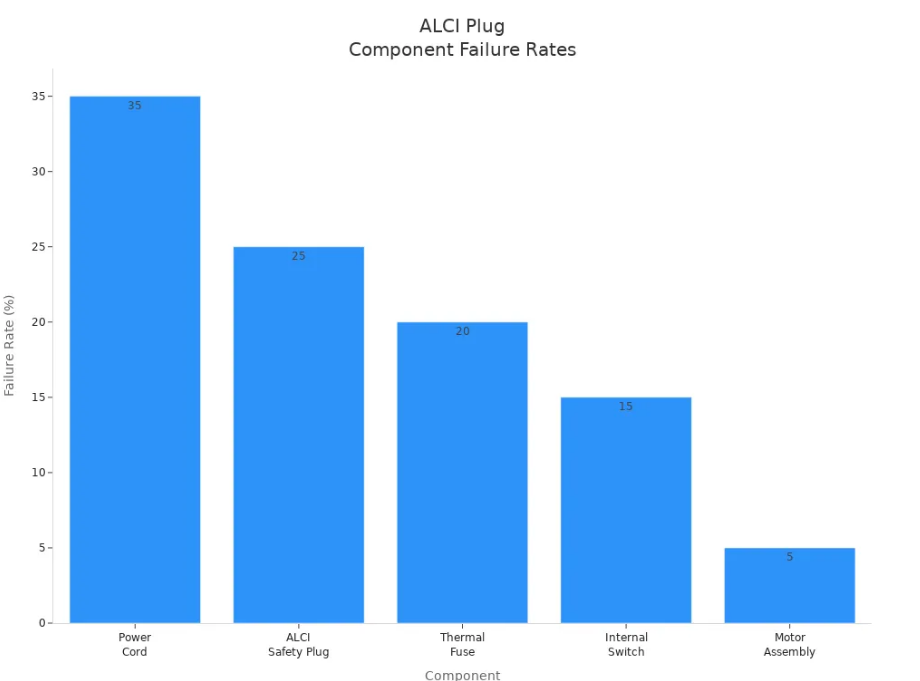An alci safety plug gives you a layer of protection against electrical shocks. You plug it into appliances near water to prevent electrocution. If it detects a problem, it instantly shuts off power and helps you avoid potentially fatal electrocution. Using this device increases your safety at home.
Tip: Always check your plug before using appliances in bathrooms or kitchens.
Key Takeaways
ALCI safety plugs protect you from electrical shocks by cutting off power when they detect a current imbalance, especially near water.
Always test your ALCI safety plug monthly to ensure it works properly. Press the test button to check functionality and reset it afterward.
Use appliances with ALCI safety plugs in wet areas and pair them with GFCI outlets for maximum protection against electrocution.
·
ALCI Safety Plug Basics


What Is an ALCI Safety Plug
You encounter the term alci safety plug when you look for ways to protect yourself from electrical shock near water. An alci safety plug, also known as an appliance leakage current interrupteror appliance leakage circuit interrupter, acts as a circuit breaker for appliances. You will notice a reset and test button on these plugs, similar to those found on gfci outlets. The main job of alci safety plugs is to interrupt power if they detect an imbalance in electrical current. This feature helps prevent electrocution and keeps you safe when you use appliances in wet areas.
You often find alci safety plugs built into hair dryers and electric shavers. These devices are common in bathrooms, where water exposure increases the risk of electrical shock. Manufacturers design alci safety plugs to meet strict electrical safety standards, so you can trust them to provide reliable protection.
Key features of an alci safety plug:
Functions as a circuit breaker for appliances near water
Includes reset and test buttons, similar to gfci outlets
Interrupts power when it detects current imbalance
Prevents electrocution and electrical shock
How an ALCI Safety Plug Works
When you plug in an appliance with an alci safety plug, the device constantly monitors the flow of electricity. If the plug detects a ground fault current of 6mA or more, it shuts down power to the appliance. This action protects you from electric shock, especially if you touch the black wire conductor and become grounded. The response time is fast—gfci outlets and alci safety plugs can interrupt the circuit within 25 to 100 milliseconds. Some advanced models respond in as little as 25 milliseconds, which means you get immediate protection.
How alci safety plugs detect and respond to danger:
Monitor electrical current for imbalances
Shut down power when ground fault current reaches 6mA or higher
Protect you from electric shock by interrupting power flow
Respond within milliseconds to prevent injury
You see these safety features most often in hair dryers and electric shavers. The combination of alci safety plugs and gfci outlets creates a strong barrier against electrical shock in bathrooms and kitchens.
Why ALCI Safety Plugs Matter
You might wonder why alci safety plugs are so important. The answer lies in their proven effectiveness. Since manufacturers started adding alci safety plugs to hair dryers in 1987, electrocution deaths have dropped sharply. Over a twenty-year period, an estimated 280 lives were saved. The use of alci safety plugs and gfci outlets together led to a 96.6% decrease in hair dryer electrocution rates.
You may hear myths about alci safety plugs and their role in home safety. The table below clears up some common misconceptions:
Myth | Reality |
All electrical appliances need ground wires for safety | Class II appliances with double insulation, like most consumer hair dryers, don’t require grounding because their plastic construction and reinforced insulation provide equivalent or superior safety. |
Hair dryers without ground wires are unsafe | Modern hair dryers without ground wires are often safer than older grounded models because they include multiple built-in safety systems (ALCI/IDCI) and don’t depend on building wiring quality for protection. |
GFCI outlets make hair dryer safety features unnecessary | Hair dryer safety devices and gfci outlets work together to provide redundant protection. The hair dryer’s alci safety plug provides appliance-specific protection, while gfci outlets protect the entire circuit. |
Dropping a hair dryer in water always causes electrocution | Modern safety regulations have reduced hair dryer electrocution deaths from 18 per year in the early 1980s to approximately 2 per year due to mandatory alci safety plugs and improved electrical codes. |
Plastic hair dryers are less durable than metal ones | Modern plastic hair dryers use advanced materials like polycarbonate and reinforced nylon that provide excellent durability while maintaining superior electrical insulation properties. |
Three-prong plugs are always safer than two-prong plugs | Safety depends on proper design and implementation. A properly engineered two-prong Class II appliance can be safer than a three-prong appliance with compromised grounding systems. |
Note: You should always use appliances with alci safety plugs in areas where water is present. Pairing these plugs with gfci outlets gives you the highest level of protection against electrical shock.
You help keep your home safe when you choose appliances with alci safety plugs and use gfci outlets in bathrooms and kitchens. You reduce the risk of electrical shock and protect yourself and your family.
ALCI Safety Plugs vs. GFCI
Key Differences
You may wonder how ALCI safety plugs and GFCI devices differ. Both protect you from electric shock, but they work in distinct ways. The table below highlights their main features:
Feature | ALCI Plugs | GFCI Devices |
Purpose | Protects individual appliances from shock | Protects against shock in wet areas |
Operation | Monitors current to detect imbalances | Cuts power when water is detected |
Reset Mechanism | Has a reset and test button on the plug | Typically built into the outlet |
Application | Used in specific appliances like hairdryers | Required in all wet areas like bathrooms |
Response Time | Cuts off power in a fraction of a second | Works with or without devices plugged in |
GFCI outlets detect ground fault current as low as 4-6 milliamps. This sensitivity helps prevent ground fault injuries in bathrooms and kitchens. The detection threshold for ALCI safety plugs is not specified, but both devices respond quickly to ground fault situations.
Typical Uses
You find ALCI safety plugs built into appliances such as hair dryers and electric shavers. These plugs protect you from ground fault current when you use the appliance near water. GFCI outlets, on the other hand, protect entire circuits in wet areas. You see GFCI outlets in bathrooms, kitchens, laundry rooms, and outdoor spaces. They guard against ground fault risks even if you plug in multiple devices.
GFCI outlets detect ground fault current and shut off power instantly.
ALCI safety plugs focus on ground fault protection for individual appliances.
Which to Choose
You should use both types of protection for maximum safety. Electrical safety experts recommend GFCI outlets for appliances near water because they prevent electrocution by cutting off power when they detect a ground fault. GFCI outlets have reduced household electrocutions by about 50% since the 1970s. Pairing appliances with ALCI safety plugs and installing GFCI outlets in wet areas gives you the best defense against ground fault current and electric shock.
Tip: Always check for a GFCI outlet in wet areas and choose appliances with ALCI safety plugs for added ground fault protection.
Using and Testing ALCI Safety Plugs
Safe Usage Tips
You can maximize your safety by following these best practices when using appliances with ALCI safety plugs:
Choose hair dryers with overheat protection and ALCI safety plugs.
Look for appliances with multiple heat settings and thermal cutoff systems.
Unplug other high-power devices to avoid overloading the circuit.
Clean the air intake filter on your hair dryer regularly to prevent overheating and reduce power consumption.
Tip: Always check the cord and plug for damage before each use.
How to Test and Reset
You should test your ALCI safety plug every month to ensure it works properly. Follow these steps:
Plug the appliance into a working outlet.
Press the "Test" button on the ALCI plug. The appliance should stop working.
Press the "Reset" button to restore power.
If the appliance does not turn back on, check the outlet and the plug for issues.
If your ALCI plug trips during use, unplug the appliance and let it cool for 10–15 minutes. Clean the lint filter and air vents before pressing the reset button again.
Troubleshooting
You may encounter issues with ALCI safety plugs. The table below shows common problems and their causes:
Component | Failure Rate | Typical Cause |
Power Cord | 35% | Wear from wrapping, internal wire breakage |
ALCI Safety Plug | 25% | Moisture detection, electrical faults |
Thermal Fuse | 20% | Overheating, lint blockage |
Internal Switch | 15% | Wear from frequent use |
Motor Assembly | 5% | Age, electrical damage |


If your ALCI plug will not reset, check for moisture or damaged cords. Make sure the circuit breaker has not tripped. Unplug all devices from the outlet before trying again. If you see burn marks, water damage, or feel a shock, stop using the appliance and replace it immediately.
You protect yourself and your family from electrical shock when you use ALCI safety plugs. These devices instantly cut power if they sense danger, especially with hair dryers near water. Test your plugs often and follow safety tips.
ALCI safety plugs make your home much safer every day.
FAQ
What is the difference between an alci safety plug and a gfci outlet?
You use an alci safety plug for individual appliances like hair dryers and electric shavers. A gfci outlet protects the entire circuit in wet areas from ground fault current.
How do you test an appliance leakage current interrupter?
You press the test button on the appliance leakage current interrupter. The appliance should stop working. Press reset to restore power and ensure a layer of protection against electrical shocks.
Can an alci safety plug prevent electrocution if you drop a hair dryer in water?
Yes, an alci safety plug detects ground fault current and shuts off power instantly. This helps prevent potentially fatal electrocution and electrical shock in bathrooms.














